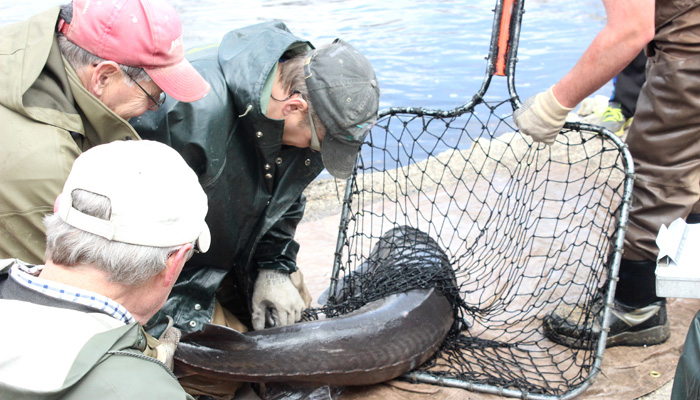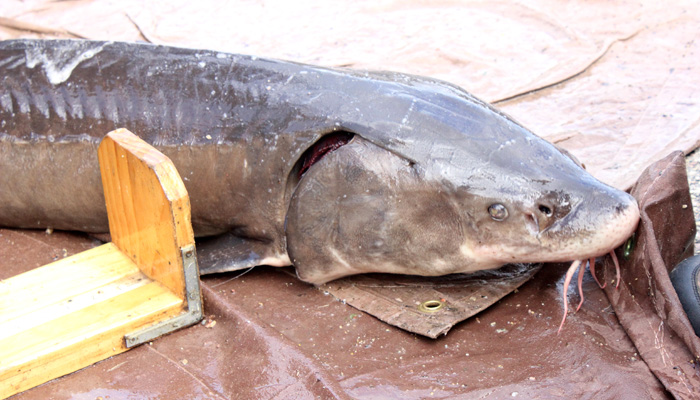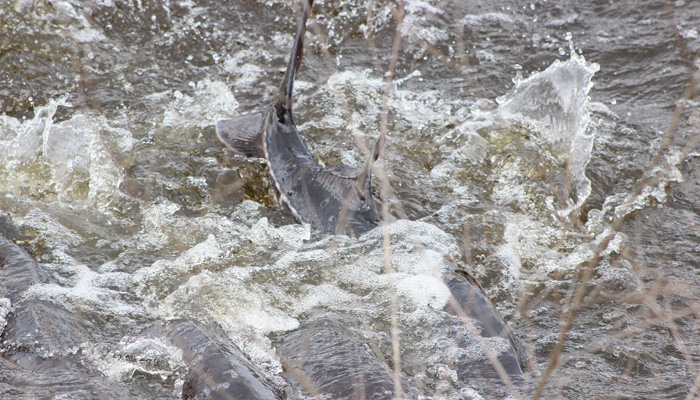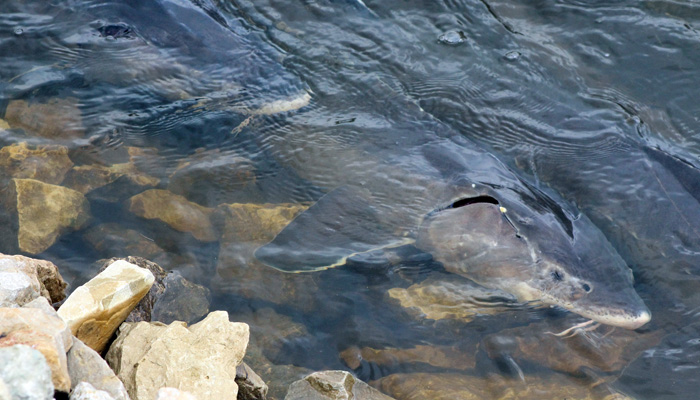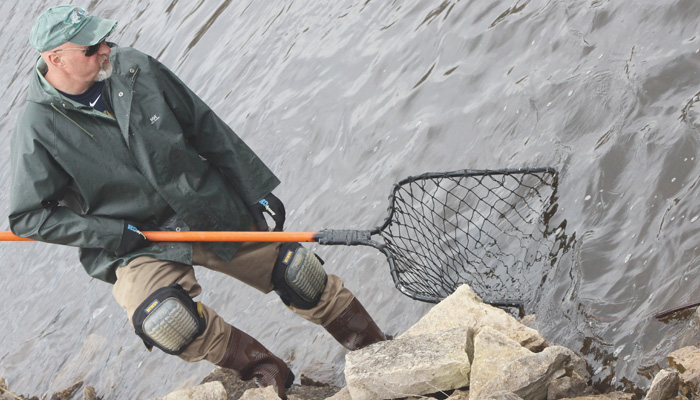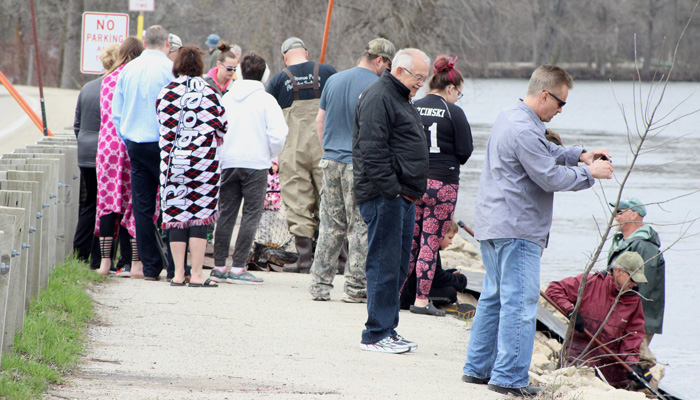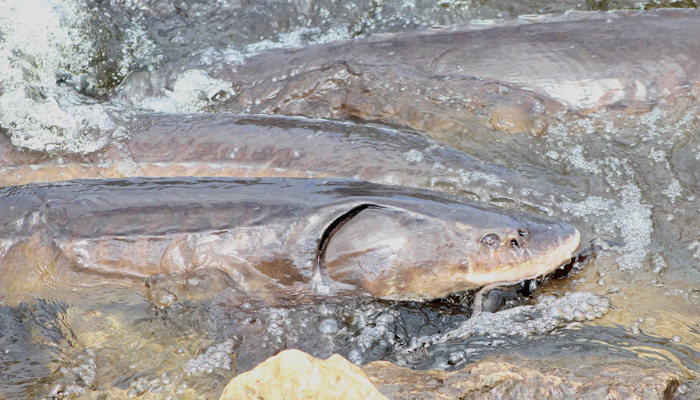Sturgeon begin trek up Wolf River
By Greg Seubert
They’re called lake sturgeon, but a river is their home this week.
Hundreds of people showed up April 17 along the Wolf River near New London and Shiocton for the annual sturgeon spawning run. Fish – many of them more than 70 inches long – head up the river each spring from Lake Winnebago to spawn along the river’s rocky shoreline.
Two of the more popular spawning areas are the Wolf River Sturgeon Trail, just west of New London along County Trunk X, and Bamboo Bend, just west of Shiocton on State Highway 54. Another is just below a dam on the Wolf in Shawano.
Ryan Koenigs, a lake sturgeon biologist with the state Department of Natural Resources, spent most of the day working a crew at Bamboo Bend, while his predecessor, Ron Bruch, joined a crew along the Sturgeon Trail.
“I was out doing some scouting (Sunday morning) on the Wolf River and fish at New London were showing some pre-spawn behavior, so I figured they’d start spawning within the next 24 hours,” Koenigs said. “Sites like this and Shawano, I didn’t see as many fish. Overnight, fish started spawning at a few sites, particularly here at Bamboo Bend and also the Sturgeon Trail.”
Drawing a crowd
Koenigs is used to big crowds showing up once word gets out that the annual ritual has started.
“It’s a unique opportunity,” he said. “You can’t go many places in the world and see sturgeon spawn at your feet like this, especially the number of fish we’re seeing here. We’ve been here since about 10:30, we’ve already handled over 100 fish and we’re not even getting a quarter of the fish that are down there. It’s the opportunity to come and see these large fish of this size. We’ve had fish up to 78 inches. You can go catch bluegills or walleyes on a number of water bodies in Wisconsin, but this is the only place where you can come and see this number of fish spawning at the same time.”
Wisconsin sells about 12,000 licenses each year for a spearing season that takes place on lakes Winnebago, Butte des Morts, Winneconne and Poygan, according to Koenigs.
“You have a population of sportsman that are interested in the fishery side of it,” he said. “They can come up here and see the fish that’ll hopefully swim through their hole some day. We see people from all different backgrounds. We see people come up here that are avid spearers that come up here every year. We see people that are retired, young kids, families, people that have never really seen a sturgeon before. This is something that’s not just for sportsman, this is something that everybody can come and witness.”
It didn’t take crews at New London and Shiocton long to capture and release more than 200 fish.
Besides recording the length of each fish, crews also attached a PIT tag, a low-frequency, passive, radio frequency identification tag used to track fish and other wildlife. The tag allows the DNR to identify the sturgeon if it is captured in the future and also provides information on movement patterns, survival and mortality rates.
“We’re netting fish with large dip nets from the shoreline,” Koenigs said. “Each fish gets measured to the nearest tenth of an inch and we determine whether their male or female. This is the only time of the year we can do that externally. The males are actually depositing sperm and the females are laying eggs. We’re also scanning them to see if they have an internal tag and looking at the fish to see if they have an external metal tag on their dorsal fin. If the fish is not tagged already with an internal tag, we’re inserting a PIT tag underneath the skull of the fish with a syringe. That tag has a unique 15-digit number to it and it’s like a Social Security number for that fish.
“Any time we handle sturgeon down the road in any of our surveys, we always scan them to see if they’re tagged so we can monitor growth, mortality, a bunch of different factors,” he added. “The biggest thing we get from tagging fish in the spring is we know how many fish of each sex we mark. During the harvest fishery and spear fishery in February, we check all fish to see if they’re tagged. That allows us to estimate how many adult males and adult females are in the population. Those numbers are used to set the harvest caps for subsequent spear fisheries. It’s really important information to have to allow that sustainable sport fishery. We have to know how many fish are out there.”
Sturgeon for Tomorrow and other groups help keep the Lake Winnebago sturgeon fishery thriving, Koenigs said.
“Local clubs do a tremendous job raising funds, donating funds and working with the DNR to create spawning habitat at sites like this,” he said. “A lot of it was paid for by donated funds. It’s really good to have that ability to have a secondary funding source rather than just state revenue. Sturgeon for Tomorrow has been around since 1977. To date, they’ve raised and donated close to $1 million to sturgeon-related research management activities. It’s great to have those partners because we’re all in this together. It’s not just the DNR that looking to manage (the sturgeon program). The public has a vested interest in what we’re doing as well. We all work together and that’s why we’ve been so successful.”
A short run
Don’t expect this year’s run to last very long.
“The run will normally last about five to 10 days depending on if there’s some temperature gradient in the river,” Koenigs said. “If I had to guess now, I’d think we’ll probably be wrapping up in Shawano this weekend. If people want to get out to see fish spawn at Bamboo Bend or New London, I really recommend they come out in the next day or two. By Wednesday, there’ll be a lot fewer fish here than there was today. People shouldn’t be waiting until this weekend thinking, ‘Oh, I’m going to go to Shiocton to see the sturgeon spawn.’ They might still see some stragglers here, but they’re not going to see the spawning activity we’re seeing today.
“I always tell people, ‘If you want to see the sturgeon spawn and you hear that they’re spawning, you better get there soon because you can’t plan for three or four days down the road,’” he said. “You also can’t look at your calendar and say, ‘Oh, I’m going to go Shiocton on April 23 and the fish are going to be there.’ They’re here for a short period of time.”
Guarding fish
Sturgeon are vulnerable to illegal harvest during the spawning period and that’s why the DNR operates the Sturgeon Guard program.
Protecting the fish used to fall completely on the state’s conservation warden force. The department created the program in the mid-1970s and opened it to volunteers from the public in 1988.
Ted Dremel, a former Waupaca County conservation warden now a warden supervisor based out of Wautoma, oversees the program.
“What we have is volunteer guards come in and help the DNR and specifically conservation wardens in watching and basically keeping people from taking sturgeon contrary to the law,” he said. “Sturgeon, when they spawn, are very vulnerable if somebody would want to take one. What we do with these guards is we provide them with our contact information. If they see something, they would document the event and contact us. If somebody takes off or whatever, we can follow up with it.”
Volunteers spend 12-hour shifts at spawning sites and start by checking in at Sturgeon Camp near Shiocton.
“Where we have active spawning sites is where they go,” Dremel said. “We try to put them on the more active sites where there are more fish. With sturgeon, it seems to be that one site can be more active than other sites at that particular time. A lot of times, our guards will be in very public places, like Bamboo Bend or the Sturgeon Trail. People come from all over the place. We’ll provide (guards) with a sturgeon fact sheet. A lot of times, they’ll answer a lot of questions. How old are sturgeon? How often do they reproduce? When do they start spawning?”
Dremel doesn’t recall any recent poaching cases, but said it used to be a major problem.
“We kind of attribute that to (the guards’) physical presence,” he said. “If somebody sees a guard there and somebody watching over the fish, they don’t mess with them. It’s hard to judge if they’re truly effective, but without any issues or problems, it’s a good record.
“I know we had one fish that was speared last year near Black Creek,” he said. “We investigated and followed up on that, but (poaching) is not what it used to be, that’s for sure. People understand now that this is a resource that we want to save.”
Guard shifts run from 6 a.m. to 6 p.m. and 6 p.m. to 6 a.m.
“Our partners with this are the sturgeon organizations like Sturgeon for Tomorrow,” Dremel said. “They pay for the food for the volunteers. We supply them with a bag lunch that they make on their own. We contracted with Hometown Grill (in Shiocton) and they supply dinner for us. They check in and we supply them with the location and give them some specifics on where to go.”
At first, Dremel felt the run could start as early as April 12.
“It’s tough to say because they’re fish and they have their own agenda,” he said. “We try to put (the guards) on the more active sites where there are more fish. With sturgeon, it seems to be that one site can be more active than other sites at that particular time. Last year, it was very unusual and it was the shortest spawning run that we’ve ever had, three days. It hit around 75 degrees for a couple of days and they all spawned.
“There is no typical spawning run,” he said. “We’ve seen fish where they start spawning, the temperatures cool and they drift back into the deep. We’ll typically see a lot of late-afternoon and early-evening spawning when the water temperatures are at their highest. If we get a cool night, the fish have a tendency to drift back out.”
Not just the Wolf
Not all spawning sturgeon head up the Wolf River. Some end up in the Little Wolf River, which flows into the Wolf west of New London.
“Another good place to go is the Manawa dam on the Little Wolf River,” Dremel said. “It doesn’t attract a lot of fish and for some reason, it seems like there are large fish there, some jumbos.”
Others find their way into the Embarrass River, which enters the Wolf in New London. Those fish can head as far north as Pella, in Shawano County.
Besides visiting popular sites, Dremel recommended using polarized sunglasses to see fish in the river’s stained water.
“Be patient,” he said. “It’s not going to be like clicking on a TV. You might have to wait for fish to come through. I think it’s kind of a neat experience. People that are locals are used to this and have seen a lot of them. When people see them for the first time, I think they’re amazed at the size of them. They’re able to view them because they come up in the shallows.
“You can see nature take its course right in front of you. If the sturgeon are really actively spawning, you see carp and redhorse suckers eating up the spawn. You might not want to see those fish eat the sturgeon spawn because you want the sturgeon to survive. It’s just the cycle of nature.”
“This is a lot of fun, but we don’t just do it because we enjoy it,” Koenigs said. “We get a lot of useful information and we wouldn’t be able to manage the spear fishery like we do without this time where we can handle these fish.”
“From what I’ve been told, our sturgeon population on the Wolf River system is the most robust in the world,” Dremel said. “It’s a very strong population, it’s not like it’s going up and down. They’re doing quite well.”

